Friday, July 27, 2007
Yumiko Tanaka / Ivar Grydeland Continental Crust 550) {this.width = 550;}"> Tracks 1 Downgoing Slab (2:59) 2 Semi Rigid Lower Mantle (9:09) 3 Young Oceanic Crust (12:00) 4 Eurasian Plate (From 7 different views) (12:22) 5 Mid-Atlantic Ridge (10:54) 6 Bonus Track (4:58) Musicians Ivar Grydeland - acoustic guitar Yumiko Tanaka - futozao shamisen, taisho-goto & voice About Continental Crust Continental Crust by Yumiko Tanaka and Ivar Grydeland is slightly folk-inspired acoustic sound improvisations captured in Osaka in April 2004. Liner notes This music was composed and recorded at the venue Bridge in Osaka on April 17th 2004. Bridge is located high above the ground in the middle of the amusement park called Festival Gate - right between slot machines and the big roller coaster. I don't think Festival Gate is Osaka's hot spot, the park is nearly empty, but Bridge is a nice and spacious venue. With relatively small acoustic instruments we tried to fill Bridge with sound and music that we find interesting. Meanwhile, we could see the roller coaster passing by every now and then - we could also hear it, and feel it. The whole building would shake each time it passed by, like a small earthquake. Maybe this wasn't the perfect recording situation, but listening to the music now I feel it gained an identity of it's own. The music on this CD somehow made me think of plate tectonics. Ivar Grydeland, Oslo, November 2004 ====================================================================== Grydeland on acoustic guitar and Tanaka on futizao shamisen (a small banjo-like instrument) and percussion somehow combine in these surreal circumstances to create improvisations of great intimacy and light. The instrumental voices are fundamentally small, however resonant, and the musicians take varied tacks to the space at hand, sometimes building dense overlays of rapid twanging lines, as on «Young Oceanic Crust» and elsewhere allowing isolated sounds to bend and waver as they decay, as in «Eurasian Plate from 7 Different Views.» The musicians have forged profoundly personal approaches to their instruments, to the extent that it's ironically difficult to tell them apart, whether it's a modified acoustic guitar or a shamisen that's carrying a particular line, but the difficulty is hardly problematical. This is music about submerging identity, whether in the free interaction of sound, floating high in space in an aged amusement park or diving in the oceanic imagination to the earth's shifting plates. It's music of compelling delicacy and rigor-especially striking when Tanaka plays and sings the traditional «Hidakagawa Iriaizakura» in the midst of an extended improvisation-but it feels resilient, not fragile, with a poetry all its own. 550) {this.width = 550;}"> http://rapidshare.com/files/19776211/TANAKA_YUMIKO___GRYDELAND_IVAR.pa rt1.rar.html http://rapidshare.com/files/19777379/TANAKA_YUMIKO
Thursday, July 26, 2007
Gordon Mumma with the ONCE Group
Electronic Music for Theatre and Public Activity
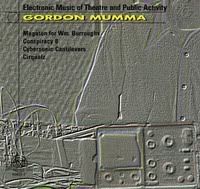
Megaton for Wm.Burroughs
Conspiracy 8
Cybersonic Cantilevers
Cirqualz
Gordon Mumma (b. 1935) has played a pioneering role in the development and evolution of “live-electronic” music. “Live-electronics” as a concept and practice appears to have originated in the United States in the late 1950s, outside the few institutional electronic studios and often in the context of innovative theatre activity. From its inception, it frequently involved two processes: (1) live performance with accompanying or interacting sound materials on magnetic tape; and (2) the use of electronic circuitry as sound-modifying and sound-producing instruments.
Beginning with his classic Megaton for Wm. Burroughs of 1963, Mumma’s live-electronic and cybersonic works of the 1960s and 1970s, especially Medium Size Mograph (1963) and Hornpipe (1967), display his resourceful use of both live-electronic processes. Cybersonic Cantilevers (1973) extends them to include the active participation of audience members, many of them children and teenagers who were quick to grasp the artistic potential of cybersonic technology, while Conspiracy 8 (1969–70) is an early example of live interaction between performers and computer. A major addition to the contemporary music discography, this is essential listening for anyone interested in the history of electronic music.
Megaton for Wm. Burroughs, Conspiracy 8 (co-composed and performed with Stephen Smoliar), Cybersonic Cantilevers, Cirqualz
http://rapidshare.com/files/44161600/Gordon_Mumma.part1.rar.html
http://rapidshare.com/files/44163616/Gordon_Mumma.part2.rar.html
Electronic Music for Theatre and Public Activity

Megaton for Wm.Burroughs
Conspiracy 8
Cybersonic Cantilevers
Cirqualz
Gordon Mumma (b. 1935) has played a pioneering role in the development and evolution of “live-electronic” music. “Live-electronics” as a concept and practice appears to have originated in the United States in the late 1950s, outside the few institutional electronic studios and often in the context of innovative theatre activity. From its inception, it frequently involved two processes: (1) live performance with accompanying or interacting sound materials on magnetic tape; and (2) the use of electronic circuitry as sound-modifying and sound-producing instruments.
Beginning with his classic Megaton for Wm. Burroughs of 1963, Mumma’s live-electronic and cybersonic works of the 1960s and 1970s, especially Medium Size Mograph (1963) and Hornpipe (1967), display his resourceful use of both live-electronic processes. Cybersonic Cantilevers (1973) extends them to include the active participation of audience members, many of them children and teenagers who were quick to grasp the artistic potential of cybersonic technology, while Conspiracy 8 (1969–70) is an early example of live interaction between performers and computer. A major addition to the contemporary music discography, this is essential listening for anyone interested in the history of electronic music.
Megaton for Wm. Burroughs, Conspiracy 8 (co-composed and performed with Stephen Smoliar), Cybersonic Cantilevers, Cirqualz
http://rapidshare.com/files/44161600/Gordon_Mumma.part1.rar.html
http://rapidshare.com/files/44163616/Gordon_Mumma.part2.rar.html
Tuesday, July 24, 2007
Masayuki Takayanagi and New Directions Independence: Tread on Sure Ground (Tiliqua Records, TILAR-5008) (Japan) (CD)

1. The Galactic System (11:27)
2. Sick, Sick, Sickness, My Aunt (1:13)
3. Study No. 3 Up and Down (5:57)
4. Herdsman's Pipe of Spain (6:46)
5. Deepnight, Swamp (1:24) 6. Piranha (13:21)
Bonus track
7. Mass Projection (4:52)
All music and arrangements by Masayuki Takayanagi
Masayuki Takayanagi and New Directions Masayuki Takayanagi: guitar Motoharu Yoshizawa: bass, cello, percussion, folk pipe, voice Yoshisaburo Toyozumi: drums, percussion
Recorded at Teichiku Kaikan First Studio, Tokyo, September 18, 1969 (1-6) and February 2, 1970 (7)
http://rapidshare.com/files/44157351/Independence.part1.rar.html http://rapidshare.com/files/44157639/Independence.part2.rar.html

1. The Galactic System (11:27)
2. Sick, Sick, Sickness, My Aunt (1:13)
3. Study No. 3 Up and Down (5:57)
4. Herdsman's Pipe of Spain (6:46)
5. Deepnight, Swamp (1:24) 6. Piranha (13:21)
Bonus track
7. Mass Projection (4:52)
All music and arrangements by Masayuki Takayanagi
Masayuki Takayanagi and New Directions Masayuki Takayanagi: guitar Motoharu Yoshizawa: bass, cello, percussion, folk pipe, voice Yoshisaburo Toyozumi: drums, percussion
Recorded at Teichiku Kaikan First Studio, Tokyo, September 18, 1969 (1-6) and February 2, 1970 (7)
http://rapidshare.com/files/44157351/Independence.part1.rar.html http://rapidshare.com/files/44157639/Independence.part2.rar.html
Saturday, July 14, 2007
Fly Away Little Bird-
Jimmy Giuffre (Artist), Paul Bley (Artist), Steve Swallow (Artist)
Review by Thom Jurek, All Music Guide
Why aren't there more recordings like Fly Away Little Bird? Perhaps it's because there aren't more musicians of this stature. The studio reunion of the legendarily experimental Jimmy Giuffre 3 in 1992 was reissued in 2003 on the French Sunnyside label and is a radical departure from anything the trio had done in the past. These studio apparitions of the band are their most seamlessly accessible while being wildly exploratory. In addition to the consummate improvisations and compositions by Giuffre (title track, a redone "Tumbleweed"), the tender meditations by Steve Swallow ("Fits" and "Starts"), and the bottom-register contrapuntal improves by Paul Bley ("Qualude"), this is a trio recording that uses standards such as "Lover Man," a radically and gorgeously reworked "I Can't Get Started," "Sweet and Lovely," and "All the Things You Are" to state hidden textural possibilities inside chromatic harmony. There is never the notion of restraint in the slow, easy, and proactive way these compositions are approached. Rather, they are traced along spectral melodic frameworks and opened up from the space provided by not having a drummer, allowing for tonal exploration and group interaction to meet in the center of a composition and grow it out to all three sides of a triangle. The moving emotions that swirl around inside these (mostly) light melodies are the most captivating and aesthetically beautiful this group has ever committed to tape. Here is a stellar display of the intricacies of musical communication as it happens and how achingly beautiful a record can be when three men listen carefully to one another's secret hearts.
1. Fly Away Little Bird
2. Fits
3. I Can't Get Started
4. Qualude
5. Possibilities
6. Tumbleweed
7. All The Things You Are
8. Starts
9. Goodbye
10. Just Dropped By
11. Lover Man
12. Postlude
13. Sweet And Lovely
14. Bats In The Belfry
http://rapidshare.com/files/6981725/Jimmy_Giuffre-paul_bley__fly_away_ little_bird.part2.rar
http://rapidshare.com/files/6980934/Jimmy_Giuffre-paul_bley__fly_away_ little_bird.part1.rar
Jimmy Giuffre (Artist), Paul Bley (Artist), Steve Swallow (Artist)
Review by Thom Jurek, All Music Guide
Why aren't there more recordings like Fly Away Little Bird? Perhaps it's because there aren't more musicians of this stature. The studio reunion of the legendarily experimental Jimmy Giuffre 3 in 1992 was reissued in 2003 on the French Sunnyside label and is a radical departure from anything the trio had done in the past. These studio apparitions of the band are their most seamlessly accessible while being wildly exploratory. In addition to the consummate improvisations and compositions by Giuffre (title track, a redone "Tumbleweed"), the tender meditations by Steve Swallow ("Fits" and "Starts"), and the bottom-register contrapuntal improves by Paul Bley ("Qualude"), this is a trio recording that uses standards such as "Lover Man," a radically and gorgeously reworked "I Can't Get Started," "Sweet and Lovely," and "All the Things You Are" to state hidden textural possibilities inside chromatic harmony. There is never the notion of restraint in the slow, easy, and proactive way these compositions are approached. Rather, they are traced along spectral melodic frameworks and opened up from the space provided by not having a drummer, allowing for tonal exploration and group interaction to meet in the center of a composition and grow it out to all three sides of a triangle. The moving emotions that swirl around inside these (mostly) light melodies are the most captivating and aesthetically beautiful this group has ever committed to tape. Here is a stellar display of the intricacies of musical communication as it happens and how achingly beautiful a record can be when three men listen carefully to one another's secret hearts.
1. Fly Away Little Bird
2. Fits
3. I Can't Get Started
4. Qualude
5. Possibilities
6. Tumbleweed
7. All The Things You Are
8. Starts
9. Goodbye
10. Just Dropped By
11. Lover Man
12. Postlude
13. Sweet And Lovely
14. Bats In The Belfry
http://rapidshare.com/files/6981725/Jimmy_Giuffre-paul_bley__fly_away_ little_bird.part2.rar
http://rapidshare.com/files/6980934/Jimmy_Giuffre-paul_bley__fly_away_ little_bird.part1.rar
Ran Blake - Rapport - Arista Novus AN 3006

Alone Together
Vanguard
Solitaire
Thursday
Wende
Biko
Arline
Breakthru
Vradiazi
The Ballad of Hix Blewitt
You Go to My Head
Recorded April 30th-May 3rd 1978, N.Y.C.
Ricky Ford, ts; Ran Blake, p; Rufus Reid, b;
http://rapidshare.com/files/42976555/ran_blake__rapport.rar.html
(ripped from vinyl- it's a bit noisy)

Alone Together
Vanguard
Solitaire
Thursday
Wende
Biko
Arline
Breakthru
Vradiazi
The Ballad of Hix Blewitt
You Go to My Head
Recorded April 30th-May 3rd 1978, N.Y.C.
Ricky Ford, ts; Ran Blake, p; Rufus Reid, b;
http://rapidshare.com/files/42976555/ran_blake__rapport.rar.html
(ripped from vinyl- it's a bit noisy)
91- Ken Ishii
Garden on the Palm (1993)
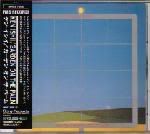
The tidal wave of dark rave and proto-Hardcore (Joey Beltram, CJ Bolland, Mundo Muzique), which had made R&S one of the most respected labels in dance music, was subsiding when Garden On The Palm made its diffident appearance. However, this double vinyl foray by a previously unknown Japanese producer remains a landmark in Electronica - elliptical, minimal, and relentlessly intriguing. Oblique electroacoustic shimmers, playful squelches, quixotic beats and alien magnetic chimes combine to produce music which follows its own dreamlike logic throughout, maintaining a wordless emotional charge without abandoning either taut economy or its unique sonic palette
http://rapidshare.com/files/42740942/91-_Ken_Ishii__garden_on_the_palm .rar
Garden on the Palm (1993)

The tidal wave of dark rave and proto-Hardcore (Joey Beltram, CJ Bolland, Mundo Muzique), which had made R&S one of the most respected labels in dance music, was subsiding when Garden On The Palm made its diffident appearance. However, this double vinyl foray by a previously unknown Japanese producer remains a landmark in Electronica - elliptical, minimal, and relentlessly intriguing. Oblique electroacoustic shimmers, playful squelches, quixotic beats and alien magnetic chimes combine to produce music which follows its own dreamlike logic throughout, maintaining a wordless emotional charge without abandoning either taut economy or its unique sonic palette
http://rapidshare.com/files/42740942/91-_Ken_Ishii__garden_on_the_palm .rar
Friday, July 13, 2007
Kang Tae Hwan Trio - Love Time CD
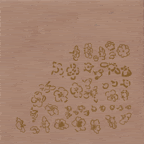
Debut release by the trio of Kang Tae Hwan, Makoto Kawabata, and Ichiraku Yoshimitsu. Group leader Hwan is an under-documented alto player from Korea who has recorded for Japanese Victor and DIW, played at Moers, toured Japan a few times, and collaborated with Gerry Hemingway and Otomo Yoshihide, among others. Active since the 70's, Hwan's discography also includes several CD's of solo alto improvisations and a duo CD with Tuvan vocalist Sainkho Namtchylak. More recently he has been collaborating with Alfred Harth during Harth's residency in Seoul. Percussionist Yoshimitsu is well-traveled in both improv and rock circles, having been a member of Omoide Hatoba and a frequent collaborator with heavyweights like Otomo Yoshide and Haco. The inescapable Makoto Kawabata is best known for his Deep Purple-style rock as a member of Acid Mothers Temple, but on his own he has produced a string of subtle, elegica solo CD's, performing on guitar, organ, electronics, etc.
More minimalist than free jazz, Love Time centers on Hwan's long circular tones, avoiding common free-alto styles in favor of a roughly-hewn clarion approach. Kawabata and Yoshimitsu shadow Hwan subtly on sarangi and bowed percussion. The music gradually builds to a crescendo, with Kawabata swtiching to guitar and Yoshimitsu moving to the drum kit. An atmospheric and understated work. 1 Track, 50 Minutes
http://www.mediafire.com/?5g3ommoxmjo
Kang Tae Hwan
Korean Free Jazz -live improvisation
PonnyCanyon Korea PCLD00002
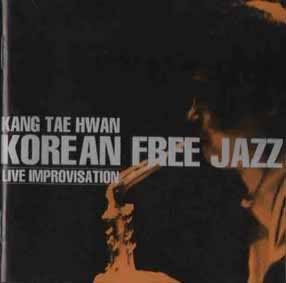
Kang Tae Hwan (as)/ Choi Sun Bar (tp -1)/ Kim Dae Hwan (perc -1)/ Takada Midori (perc -2)/ Evan Parker (ss -3)
1.Soul Free Music Trio (11'23)/ 2-3.Duo (13'27)/ 4.Duo (15'09)/ 5.Solo (7'22)
Recorded live at FM Tokyo Hall, Tokyo, on 23rd of June, 1988 (1, 4),
live at Suntory Hall, Tokyo, on 3rd of July, 1988 (2),
live at Yeh Eum Hall, Seoul, on 14th of September, 1988

http://www.mediafire.com/?dmuyomnzkqh

Debut release by the trio of Kang Tae Hwan, Makoto Kawabata, and Ichiraku Yoshimitsu. Group leader Hwan is an under-documented alto player from Korea who has recorded for Japanese Victor and DIW, played at Moers, toured Japan a few times, and collaborated with Gerry Hemingway and Otomo Yoshihide, among others. Active since the 70's, Hwan's discography also includes several CD's of solo alto improvisations and a duo CD with Tuvan vocalist Sainkho Namtchylak. More recently he has been collaborating with Alfred Harth during Harth's residency in Seoul. Percussionist Yoshimitsu is well-traveled in both improv and rock circles, having been a member of Omoide Hatoba and a frequent collaborator with heavyweights like Otomo Yoshide and Haco. The inescapable Makoto Kawabata is best known for his Deep Purple-style rock as a member of Acid Mothers Temple, but on his own he has produced a string of subtle, elegica solo CD's, performing on guitar, organ, electronics, etc.
More minimalist than free jazz, Love Time centers on Hwan's long circular tones, avoiding common free-alto styles in favor of a roughly-hewn clarion approach. Kawabata and Yoshimitsu shadow Hwan subtly on sarangi and bowed percussion. The music gradually builds to a crescendo, with Kawabata swtiching to guitar and Yoshimitsu moving to the drum kit. An atmospheric and understated work. 1 Track, 50 Minutes
http://www.mediafire.com/?5g3ommoxmjo
Kang Tae Hwan
Korean Free Jazz -live improvisation
PonnyCanyon Korea PCLD00002

Kang Tae Hwan (as)/ Choi Sun Bar (tp -1)/ Kim Dae Hwan (perc -1)/ Takada Midori (perc -2)/ Evan Parker (ss -3)
1.Soul Free Music Trio (11'23)/ 2-3.Duo (13'27)/ 4.Duo (15'09)/ 5.Solo (7'22)
Recorded live at FM Tokyo Hall, Tokyo, on 23rd of June, 1988 (1, 4),
live at Suntory Hall, Tokyo, on 3rd of July, 1988 (2),
live at Yeh Eum Hall, Seoul, on 14th of September, 1988

http://www.mediafire.com/?dmuyomnzkqh
matsuo ono / takehisa kosugi "roots of electronic sound"

a reproduction of a 1979 victor label reissue of a 1975 lp on the legendary alm label featuring a series of short tape music experiments, recorded between 1963 and 1966 by matsuo ono, with assistance from none other than takehisa kosugi. the artwork and libretto on the lp are full of references to “atom” (better known to westerners as “astro boy”), a mid-60s japanese cartoon to which many of these tape-sounds were used as sound effects and incidental music... pretty incredibly given how zonked & explosion-oriented these short pieces are.
the whole thing comes across as an earlier, analog version of jean-claude risset’s catalogue of computerized sound synthesis (i.e. each cue is announced beforehand by a loud/distorted japanese voice solely in the right/left channel.) as the record progresses, the jabs get longer and longer, until morphing into a suite of fully realized, multi edit-per-second blasts & cosmic drift that rival only the earliest wdr & ina-grm lineage tape-music etudes. one of the key pieces historical japanese electronic music puzzle, entirely fantastic & completely necessary...
(5 tracks -tracks 1-4 contain intros in japanese before each short piece- track 5 contains no vocals pure electronic music)
(a creel pone limited release)
http://www.mediafire.com/?bzm0d4tmtom

a reproduction of a 1979 victor label reissue of a 1975 lp on the legendary alm label featuring a series of short tape music experiments, recorded between 1963 and 1966 by matsuo ono, with assistance from none other than takehisa kosugi. the artwork and libretto on the lp are full of references to “atom” (better known to westerners as “astro boy”), a mid-60s japanese cartoon to which many of these tape-sounds were used as sound effects and incidental music... pretty incredibly given how zonked & explosion-oriented these short pieces are.
the whole thing comes across as an earlier, analog version of jean-claude risset’s catalogue of computerized sound synthesis (i.e. each cue is announced beforehand by a loud/distorted japanese voice solely in the right/left channel.) as the record progresses, the jabs get longer and longer, until morphing into a suite of fully realized, multi edit-per-second blasts & cosmic drift that rival only the earliest wdr & ina-grm lineage tape-music etudes. one of the key pieces historical japanese electronic music puzzle, entirely fantastic & completely necessary...
(5 tracks -tracks 1-4 contain intros in japanese before each short piece- track 5 contains no vocals pure electronic music)
(a creel pone limited release)
http://www.mediafire.com/?bzm0d4tmtom
Sounds Like A Sandwich
Cato Salsa Experience and The Thing with Joe McPhee
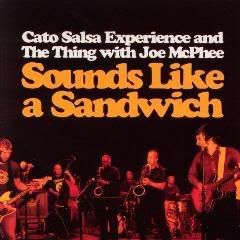
Sometimes you can't help bursting out laughing while listening to a record. Sounds like a Sandwich, a twenty-minute EP with a most appropriate title, is one of those releases. It features a Norwegian psychedelic rock band, Cato Salsa Experience, together with a jazz power trio, The Thing, and reed man Joe McPhee—or as they call themselves, two bands and a legend. The idea of Joe McPhee blowing Led Zeppelin's “Whole Lotta Love” may sound outrageous at the beginning, but after the initial laughs you'll find yourself pushing the replay button again and again.
The Thing (saxophonist Mats Gustafsson, bassist Ingebrigt Håker Flaten, and drummer Paal Nilssen-Love) has a history of playing non-standard covers. The group has already covered PJ Harvey's “To Bring You My Love” (She Knows, Crazy Wisdom, 2001) and the White Stripes' “Aluminum” (Garage, Smalltown Supersound, 2004), and has collaborated closely with McPhee. The Thing's collaboration with CSE began last summer at Kongsberg Jazz Festival in Norway, where this EP was recorded live, and continued with a studio recording that is supposed to be released later this year, as well as an upcoming Norwegian tour later this summer.
The EP begins with CSE's title tune, and you get the idea when Gustafsson and McPhee begin to rip the air in the middle of the short song. CSE's two guitarists manage to recreate Jimmy Page's huge, primitive guitar riff on “Whole Lotta Love,” which is still effective after more than thirty years, but it is clear that no singer can contest Robert Plant's vocal cords. In any case, Gustafsson's baritone solo and McPhee's supporting tenor sax skyrocket the song into the stratosphere. Nilssen-Love adds some Elvin Jones-que sophistication to Bonham's original thumping. The Yeah, Yeah Yeahs' “Art Star” was covered on The Thing's Garage; here it enjoys the reckless rhythm that CSE injects into the chorus.
McPhee shines through Don Ayler's “Our Prayer,” first on his muted pocket trumpet and later in a beautiful tenor sax duet with Gustafsson. CSE's Bard Enerstad's organ adds a gospelish tinge to this quiet track, while Cato Salsa's gritty guitar pushes it to the edge. The concluding track, “Hardcore Mama,” is a simple tune, just like the opener, that uses a catchy guitar riff and lets Gustafsson and McPhee blow the chorus as if they were in some left-of-center R&B brass band
Track listing: Sounds Like A Sandwich (CSE); Whole Lotta Love (Page, Plant, Jones, Bonham); Art Star (Yeah, Yeah, Yeahs); Our Prayer (Don Ayler); Hardcore Mama (CSE).
Personnel: Cato Salsa Experience: Cato Salsa: guitar, vocals; Bard Enerstad: guitar, organ, theremin, vocals; Christian Engfelt: bass, vocals; Jon Riise: drums. The Thing with Joe McPhee: Mats Gustafsson: baritone and tenor saxophone; Ingebrigt Håker Flaten: doublebass; Paal Nilssen-Love: drums; Joe McPhee: tenor saxophone, pocket trumpet.
http://rapidshare.com/files/16603917/Cato_Salsa_Experience___The_Thing _With_Joe_Mcphee__sounds_like_a_sandwich.rar.html
Cato Salsa Experience and The Thing with Joe McPhee

Sometimes you can't help bursting out laughing while listening to a record. Sounds like a Sandwich, a twenty-minute EP with a most appropriate title, is one of those releases. It features a Norwegian psychedelic rock band, Cato Salsa Experience, together with a jazz power trio, The Thing, and reed man Joe McPhee—or as they call themselves, two bands and a legend. The idea of Joe McPhee blowing Led Zeppelin's “Whole Lotta Love” may sound outrageous at the beginning, but after the initial laughs you'll find yourself pushing the replay button again and again.
The Thing (saxophonist Mats Gustafsson, bassist Ingebrigt Håker Flaten, and drummer Paal Nilssen-Love) has a history of playing non-standard covers. The group has already covered PJ Harvey's “To Bring You My Love” (She Knows, Crazy Wisdom, 2001) and the White Stripes' “Aluminum” (Garage, Smalltown Supersound, 2004), and has collaborated closely with McPhee. The Thing's collaboration with CSE began last summer at Kongsberg Jazz Festival in Norway, where this EP was recorded live, and continued with a studio recording that is supposed to be released later this year, as well as an upcoming Norwegian tour later this summer.
The EP begins with CSE's title tune, and you get the idea when Gustafsson and McPhee begin to rip the air in the middle of the short song. CSE's two guitarists manage to recreate Jimmy Page's huge, primitive guitar riff on “Whole Lotta Love,” which is still effective after more than thirty years, but it is clear that no singer can contest Robert Plant's vocal cords. In any case, Gustafsson's baritone solo and McPhee's supporting tenor sax skyrocket the song into the stratosphere. Nilssen-Love adds some Elvin Jones-que sophistication to Bonham's original thumping. The Yeah, Yeah Yeahs' “Art Star” was covered on The Thing's Garage; here it enjoys the reckless rhythm that CSE injects into the chorus.
McPhee shines through Don Ayler's “Our Prayer,” first on his muted pocket trumpet and later in a beautiful tenor sax duet with Gustafsson. CSE's Bard Enerstad's organ adds a gospelish tinge to this quiet track, while Cato Salsa's gritty guitar pushes it to the edge. The concluding track, “Hardcore Mama,” is a simple tune, just like the opener, that uses a catchy guitar riff and lets Gustafsson and McPhee blow the chorus as if they were in some left-of-center R&B brass band
Track listing: Sounds Like A Sandwich (CSE); Whole Lotta Love (Page, Plant, Jones, Bonham); Art Star (Yeah, Yeah, Yeahs); Our Prayer (Don Ayler); Hardcore Mama (CSE).
Personnel: Cato Salsa Experience: Cato Salsa: guitar, vocals; Bard Enerstad: guitar, organ, theremin, vocals; Christian Engfelt: bass, vocals; Jon Riise: drums. The Thing with Joe McPhee: Mats Gustafsson: baritone and tenor saxophone; Ingebrigt Håker Flaten: doublebass; Paal Nilssen-Love: drums; Joe McPhee: tenor saxophone, pocket trumpet.
http://rapidshare.com/files/16603917/Cato_Salsa_Experience___The_Thing _With_Joe_Mcphee__sounds_like_a_sandwich.rar.html
VITO PRICE/SWINGIN' THE LOOP
1. Time After Time2. Bye Strain
3. Beautiful Love
4. Credo
5. As Long as I Live
6. Swinging the Loop
7. Mousey's Tune
8. Why Was I Born?
9. Duddy
10. In a Mellow Tone
Rare work from obscure Chicago tenor player Vito Price -- recorded back in the days when there actually used to be a jazz scene in the loop! Price moved to Chicago in the mid 50s, and is typical of the white players in the city who were able to shift between club work and better-paying union gigs for TV and radio stations. The groove here isn't totally hard, but there's some nice moments, with kind of a Basie-esque flair. Titles include "Credo", "Eye Strain", "Swingin The Loop", "Mousey's Tune", and "Duddy".
http://www.mediafire.com/?6iqhmlnmjii
Thursday, July 12, 2007

Paul Moravec: The Time Gallery; Protean Fantasy; Ariel Fanstasy
1. Bells: Devotional Hours
2. Time Machine
3. Pulse: The Feeling Of What Happens
4. Overtime: Memory Sings
5. Protean Fantasy
6. Ariel Fantasy
Composer: Paul Moravec Performer: eighth blackbird, Aaron Shorr, Petter Sheppard Skærved Paul Moravec, the 2004 Pulitzer Prize winner for music, collaborated with crack new music ensemble eighth blackbird to create a riveting, fascinating, and downright fun exploration of time and our relationship to it.
Children Of Ibeji, ENJA, USA 1992
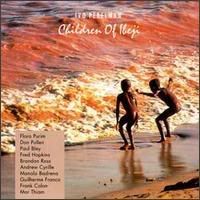
1. Mina Do Sante
2. O Morro
3. Chant For Logum
4. Oh! Que Noite Tao Bonita
5. Chant For Oshum
6. Chant for Oshala
7. Little Rocks of Aruanda
8. Tom's Diner
9. Chant for Ibeji
10. Cantara
http://anonym.to/?http%3A%2F%2Frapidshare.com%2Ffiles%2F39603333%2FChildren_Of_Ibeji.part1.rar.html
http://anonym.to/?http%3A%2F%2Frapidshare.com%2Ffiles%2F39606546%2FChildren_Of_Ibeji.part2.rar.html

1. Mina Do Sante
2. O Morro
3. Chant For Logum
4. Oh! Que Noite Tao Bonita
5. Chant For Oshum
6. Chant for Oshala
7. Little Rocks of Aruanda
8. Tom's Diner
9. Chant for Ibeji
10. Cantara
http://anonym.to/?http%3A%2F%2Frapidshare.com%2Ffiles%2F39603333%2FChildren_Of_Ibeji.part1.rar.html
http://anonym.to/?http%3A%2F%2Frapidshare.com%2Ffiles%2F39606546%2FChildren_Of_Ibeji.part2.rar.html
denis smalley “the pulses of time” compact disc recordable
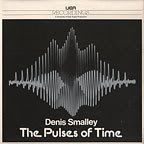
* the pulses of time (19:58) 1979
* pentes (12:53) 1974
* chanson de geste (16:25) 1978
creel pone of a 1981 lp privately released by the university of east anglia containing three sparse musique concrète pieces composed between 1974 and 1979 at the grm and uea studios by new zealand born/bred composer denis smalley.
widely considered to be one the classics of early british electro-acoustic music (alongside trevor wishart’s “journey into space” & “red bird”, desmond leslie’s “music of the future”, and basil kirchin’s “worlds within worlds”), the three pieces on “pulses” each work discrete combinations of synthesized timbres, processed close-mic’ed instrumentation, and slowly shifting/morphing drones...
no shortage of documentation on the modus/practices at work here, so i’ll let the libretto (below) do the talking... those who found favor and/or inspiration within the hilda dianda, jocy de oliveira, and/or “new zealand electronic music” creel pones will be in familiar terrority here...
electro-acoustic music uses electronic technology to create and transform sounds. it harnesses the resources of the recording studio, synthesizers, specialised treatment devices, and computers for musical composition and performance.
the three works on this record represent two types of electroacoustic music. the pulses of time and pentes exist only on stereo tape and were composed using the resources of the studios where they were created, the groupe de recherches musicales, paris, which now forms part of the institut national de l'audiovisuel, and the recording and electronic studio at the university of east anglia, england. both works involve extensive transformation of instrumental and electronic sounds. chanson de geste on the other hand is a live performance piece which needs closely positioned microphones to magnify sounds otherwise inaudible, and to enable detailed sound-balancing.
the three works were composed over a period of five years.
pentes (1974) has been widely acclaimed and with another of denis smalley's works won the fylkingen prize for electronic composition in sweden in 1975. chanson degeste (1978) which uniquely combines new vocal techniques with clavichord sounds was composed for carol plantamura, one of the foremost american sopranos specialising in new music. the pulses of time (1979) has been widely broadcast and performed in concerts and festivals in many parts of the world
denis smalley, born in new zealand, in 1946, now iive:s in england and works in norwich where he is lecturer in music at the university of east anglia. his music displays consummate skill in using electro-acoustic resources in a strikingly imaginative and individual manner.
http://rapidshare.com/files/39618497/Denis_Smalley.part1.rar.html
http://rapidshare.com/files/39619082/Denis_Smalley.part2.rar.html
enjoy......

* the pulses of time (19:58) 1979
* pentes (12:53) 1974
* chanson de geste (16:25) 1978
creel pone of a 1981 lp privately released by the university of east anglia containing three sparse musique concrète pieces composed between 1974 and 1979 at the grm and uea studios by new zealand born/bred composer denis smalley.
widely considered to be one the classics of early british electro-acoustic music (alongside trevor wishart’s “journey into space” & “red bird”, desmond leslie’s “music of the future”, and basil kirchin’s “worlds within worlds”), the three pieces on “pulses” each work discrete combinations of synthesized timbres, processed close-mic’ed instrumentation, and slowly shifting/morphing drones...
no shortage of documentation on the modus/practices at work here, so i’ll let the libretto (below) do the talking... those who found favor and/or inspiration within the hilda dianda, jocy de oliveira, and/or “new zealand electronic music” creel pones will be in familiar terrority here...
electro-acoustic music uses electronic technology to create and transform sounds. it harnesses the resources of the recording studio, synthesizers, specialised treatment devices, and computers for musical composition and performance.
the three works on this record represent two types of electroacoustic music. the pulses of time and pentes exist only on stereo tape and were composed using the resources of the studios where they were created, the groupe de recherches musicales, paris, which now forms part of the institut national de l'audiovisuel, and the recording and electronic studio at the university of east anglia, england. both works involve extensive transformation of instrumental and electronic sounds. chanson de geste on the other hand is a live performance piece which needs closely positioned microphones to magnify sounds otherwise inaudible, and to enable detailed sound-balancing.
the three works were composed over a period of five years.
pentes (1974) has been widely acclaimed and with another of denis smalley's works won the fylkingen prize for electronic composition in sweden in 1975. chanson degeste (1978) which uniquely combines new vocal techniques with clavichord sounds was composed for carol plantamura, one of the foremost american sopranos specialising in new music. the pulses of time (1979) has been widely broadcast and performed in concerts and festivals in many parts of the world
denis smalley, born in new zealand, in 1946, now iive:s in england and works in norwich where he is lecturer in music at the university of east anglia. his music displays consummate skill in using electro-acoustic resources in a strikingly imaginative and individual manner.
http://rapidshare.com/files/39618497/Denis_Smalley.part1.rar.html
http://rapidshare.com/files/39619082/Denis_Smalley.part2.rar.html
enjoy......
Subscribe to:
Comments (Atom)
